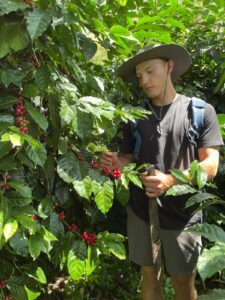OUR MISSION /
TO COLLABORATE WITH ENTHUSIASTIC SMALLHOLDER COFFEE FARMERS. TO PUSH THE BOUNDARIES OF COFFEE PROCESSING. TO UNCOVER NEW FLAVOUR TERRAINS.
Meet Ana, Nicolas and Juan from Pillcocaja Farms!
Not only does this family-run farm produce some amazing coffees, but they are also leading the way in terms of equal rights and work opportunities for women! We have had the immense pleasure to visit this farm in person to observe and learn from this progressive coffee farm. It’s been one amazing experience and we can’t wait to share a cup of the results with you!
ORIGIN JOURNALS /

day 1 at pillcocaja
Ecuador
1st day in pillcocaja. Ana and nico gave us a tour of the farm. We hiked up the mountain to an area where they grow different varieties of coffees in seven lots. These are typica, Bourbon, pacamara, sidra, eithope.
Trees are full of cherries ready to be pick. Constant rain is blamed for a late 2022 harvest. Trees look healthy and well spaced out in rows. Every year the top is cut to keep the plant short. This is done so the pickers can reach the cherry and encourages growth outwards. Some trees have coffee blossoms ready to start growing for next years harvest. This usually take 9 months from blossom to ripe cherry.
Cherries are at an average of 24-25 brix. Mucilage is so sweet and taste like papaya and the passion fruit. Three seeds in a cherry are quite common here. Very well shaded with old native trees called faiques and irrigated from fresh mountain springs.
It’s evident that they care for native wildlife. Spiders, snakes, butterflies are left alone. They all play a part in the farm.
We stopped at the wet mill where we later watch todays pickings where the cherries are floated, ripe cherries picked and split into categories.
We continued down the hill to look at their new solar tent with raised beds. The set up is amazing. They have temperature and humidity readers dangling in different spots. All beds are at one height. Nico reckons having tiered beds aren’t consistent from top to bottom in terms of drying.
After lunch we helped with the day pickings. Sorting and washing coffee. Wet mill set up is amazing. Clean and user friendly. These guys thought of everything, making the process more efficient but also safe and less labour intensive.
We filled two tanks with cherries. These are going to be 120hours anaerobic.
We headed back to the house and helped with dinner. Tomorrow we are heading to Cuenca to see the dry mill and do some cupping.
Love Darren and Manny 👊🏽

more adventures
Buenas tardes zest,
Since our last entry, Darren and myself have been busy little bees. Our second day in pillcocaja was exciting. Ana and Nico organised the day to explore the dry mill. It’s located in Cuenca. A two hour drive from the farm. Once we arrived at cafe exporto we had a tour of the factory.
It’s a small operation, but impressive. Juan Peña is the founder and CEO of Cafe exporto and hacienda La Papaya.
After the tour, we cupped seven coffee in the QA room. These where
– ethiopa red honey
– typica washed
– pacamara anaerobic
– typica anaerobic natural
– typica natural
– sydra anaerobic
We then headed to the family’s beverage company. It’s an impressive set up. Had a tour of the entire Zhumir factory. We finished in the museum.
The museum is where we did the zoom call with pillcocaja. Here they showed us the differences in water. From tap, some minerals and RO. We finished the day with a tasting of 7 year old and 18 year aged rum.
3rd day at the beautiful Ecuadorian Andes . After breakfast we headed up to the coffee farm. Today we picked the ripest cherries for our experimental lot. It took me 4 hours to pick 1 bucket 🤣. Definitely hard work. Lucky we had a cloudy day and wasn’t overly hot. Darren captured some drone footage and more photo content.
After lunch and a little nap 😁we made our way to the wet mill. Here we met the pickers sorting the cherries picked for the day. We collected our floated and washed cherries and proceeded to the house. Here is where they keep the large tank.
After collecting all the necessary equipment, we started our process at 6.30pm. It took us 2.5 hours to contrast bath the cherries.
We dropped cherries in a warm bath at a controlled 40degrees for about 3.30 minutes then straight into a ice cold bath at a controlled 10 degrees.
We filled the large vessel, sealed and purged with co2 to 10 psi then drained to 8 psi.
We slept well that night 😊.
Sunday we started the day and discussed option for purchasing coffee. Darren and I locked in the following
2 boxes red honey Etiopa
2 boxes typica washed
3 boxes typica anaerobic natural
3 boxes typica yellow honey
3 boxes sydra anaerobic
1.5 boxes experimental lot
After meeting we headed to el chorro del giron. Spent an hour hiking and waterfall seeing. We proceed to Cuenca for our hotel check in. Early night as we had a 5am wake up call to head to airport.
Adiós de dos chicos cansados 🥱😴

our process
An outline of the coffee that we processed at Pillcocaja. 😃
Double Fermentation CM W/ contrast bath
Varietal- Typica
Process
– Cherries steeped @ 40•c for an average of 4mins
– Cherries then steeped @ 10•c for 1min
– Cherries added to steel tank
– Tank flushed with Co2 at 8psi CM
Fermentation
– Cherries fermented CM for 80hours
– Cherries pulped & parchment added back to the tank for another 40 hours CM
– Coffee dried as a washed process

